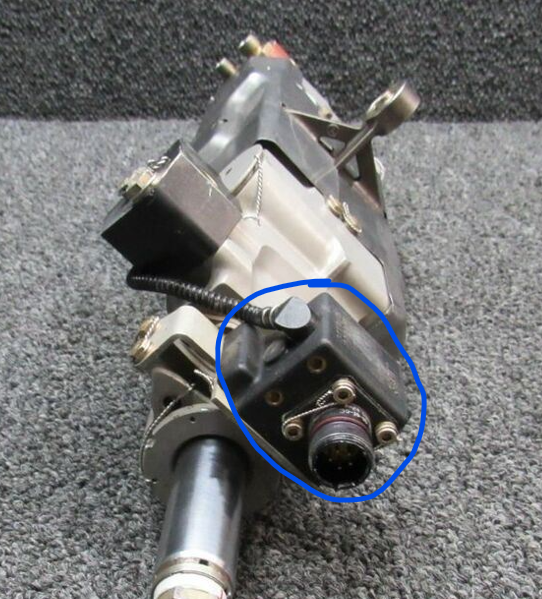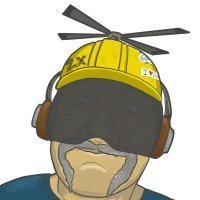All Activity
- Yesterday
-
Helijedi joined the community
- Last week
-
aerolithium started following GPU usage
-
What methods are people using , GPU, to start their engines ? I dont see any talk about that here.
-
aerolithium joined the community
-
Chuckarmypilot joined the community
-
altownsend joined the community
- Earlier
-
Looking for a Bell 47 Heater kit number 47-706-650
-
AdamDarby joined the community
-
With your flying experience you'll likely do very well in flight school. The hard part will be adopting the Army mentality. You're almost to where you are done paying for ratings. You're almost to a point where you can get yourself a good job. You'll most likely be sitting in whatever seat you want before you'll be even halfway through your Army commitment. It's going to take you at least 2 years to work your way through the Army training pipeline, maybe more depending on how long your packet takes. Then 10 more years to complete your commitment. So from right now you will be at least 12 years down the line before you'll be free again to take your life and career where you want to go. 37 years old. Consider also that signing up for the Army is signing your life away. Full stop. You are committing to sacrifice your life in service to your country. That should scare you a little bit. OK. Shifting gears. A couple weeks from now will be the 15th anniversary of when I left home for the Army. I was 20 years old and had been working on my PPL for a few years, while working the flight line at FBOs. Couldn't afford community college, couldn't afford flying, and wasn't doing well at either. The recession was in full swing. All I wanted to do was fly. WOFT was my answer. I've had a great career so far. I'm now flying airliners, which is where I wanted to be when I started flying almost 20 years ago. I enjoyed the Army, grew so much as a person, was afforded opportunities I didn't have, I made memories, friendships, saw the world, etc. I have a ton of pride in my service. I am a much better pilot because of my experience than I think I would have been without it. There are days I miss the Army. To wrap this up. WOFT is a huge commitment. To be successful you're going to have to embrace it and forget about civilian life for a decade. Like, don't even think about it. The airlines, living at home, whatever. They should not be on your radar at all. You will be an Army Aviator and only an Army Aviator. If you think you can do that and enjoy it, then go for it.
-
R22 or Bell 47 ??
Chuckarmypilot replied to Shack's topic in Helicopter Flight Training - School Reviews
I'm an old guy, I learned to fly in the Army, 1968. Flew the TH-55, (Hughes 269 I believe). Then Bell 47, called the TH-13 because it had the huey instrument panel, for instrument training. Then the UH-1H and UH-1C in Vietnam, later the OH-58 AND Blackhawk. I've never got accustom to spending a great deal of cash as the Army didn't pay much. So since the basics of helicopters is about the same, I'd start with the R22, maybe not glamorous but half the price to learn to fly, then move up. That's what I'm doing with my grandson who wants to follow his grandpa, high school to Army flight school. Just want to make sure he's ready, my first flight was holding onto that TH-55, WOW, not easy! Love to hear from you young guys learning to fly. Congratulations....go for it. -
Jeron1974 joined the community
-
I'm abit of an anomaly here. I am really wanting to become a mustering pilot. Yes I am currently jumping through the hoops of Casa Medical and nearing the end before they decide if I can have a class 1 approved. I'm 50yrs old. I have an above knee amputation. I still work and walk etc like everyone else but with a slight limp. I have worked on stations in my younger years so I understand outback living and working conditions. How cattle move when mustering on horseback and motorbike. I don't have any connections in the industry as I currently work as a Pathology Collector. Would I get a chance to be offered work out on stations once I got my CPL Helicopter license's and all other requirements or would I be seen as a high risk? I've talked to Casa and they cannot give me any definitive answers. I have spoke to operators and flight schools but I thought i would see what pilots would suggest on here? I appreciate all advice and comments. Thank you
-
Indentifying Helicopter Cyclic Grip
Disguise Delimit replied to CrashMeTwice's topic in General Helicopter Forum
Looks the same as in an S-76, apart from the metal guard over the transmit trigger. -
nvcontractingllc joined the community
-
Anyone ever start a tour company from scratch? Whats that process like? Im assuming that without a huge amount of capital youd need to take out a fairly hefty small biz loan, lease the aircraft and go through the process of becoming a part 135 operator, what else am I missing? I live in a fairly scenic area and have been kicking the idea around in my head
-
CaiJH60 started following Helicopter Ferry Flights, Time Building, and Flying Clubs
-
Indentifying Helicopter Cyclic Grip
CaiJH60 replied to CrashMeTwice's topic in General Helicopter Forum
Probably a bunch of old sikorsky birds, looks identical to the one in an H-60L but the labels are different and the radio switch is different -
What kind of paint do you use for an SPH5? Spray paint, any specific brand or type of paint, etc? Has anyone ever tried cerakoting? I’m curious if the graphlon would handle the temperature. I want to paint mine a black graphite color.
-
Current military helo pilot, background as a maintenance test pilot. Asking to see if anyone has experience in aviation within FBI or alongside with them. All I can find is they do have a tactical helicopter unit, however no details on where and how they get their pilots. Any required minimums? Cannot seem to find much online about aviation in the FBI.
-
allcric changed their profile photo
-
Taking a look at your options is a great first step. First ask yourself these questions. Do I want to be a Soldier? Because that will and does come first. Next do I want to be an Army Aviator? What is that? and what does that involve? What types of aircraft, missions etc. There are always dues to pay, staying on your current civilian path or choosing the Army. The current service obligation for flight school is 10yrs. Your current skills will help you although not required, the Army will teach you what you need to know about helicopters. At least how the Army uses helicopters! Just some thoughts, Best of Luck. Zoner
-
Hi, Does anyone has had electrical failure experience on the electrical circuit of rotor servos of AIRBUS helicopters? The problem is offten seen in Brazil and I´m wondering if is there any maintenance technic on the helicopter that is contrbuting for this occurency, so we can improve it and reduce this cost. Thanks for any advice or experience shared.
-
Preventing frost acumulation
boardutah replied to Wally's topic in Helicopter Emergency Medical Services - EMS Board
Aside from the additional starting cycles on the engine, if you're starting it every 2 hours, what happens if you get a flight at the 1 hr 50 min mark? You're gonna have to run it up, then shut it down, then get out and inspect the blades, then run it back up again. That vs just putting covers on from the start; removing the blade covers will definitely take less time. That being said.. if you let a little FROST get on your blades, you won't even feel a difference if you start up and fly. No big deal. ICE and SNOW on the other hand are obviously different. -
I apologize if this has been asked previously, but I was I unable to find any discussions related. To give a background, I am a 25 year old male, have an associates degree, and multiple civilian pilots licenses up to commercial multi engine airplane. I have been working a full time job to pay for my CFI license (flight instructor), but am terrified of getting stuck in a cycle of working jobs to continue saving. My local recruiter reached out to me recently to discuss routes I may be able to take with the Army. I have been doing a lot of research on the street to seat WOFT program the Army offers, and I am extremely interested. I understand the physical and mental demand the program will face me with, but am very curious to find out how my current skills and knowledge in aviation will translate. I know absolutely nothing about helicopters currently. I am also eager to take any advice you all would have to offer.
-
I know it’s an old thread but someone find it useful to know that you an get a s64 Skycrane according to conditions and location for average of 9 to 13 thousand an hour
-
TomPPL started following Bell 47 G-4A Rotor Gearbox and Indentifying Helicopter Cyclic Grip
-
Hi! I’m currently in the market to purchase Bell 429. If you guys have any information, please let me know. Thanks!
-
Greetings! Please help me to identify which helicopter this grip belongs to. SIKORSKY Helicopter GRIP ASSY S1640-62104-6J Thanks!
-
I hope you're still around! I stumbled upon your post from four years ago, and I couldn't help but wonder how your career journey has unfolded since then. It's been quite a while, and I hope you've managed to find the clarity and fulfillment you were seeking back then. Transitioning from aerospace engineering to rotor-wing aviation is a bold move, but it sounds like it could have been the right choice for you. Griffin Cleverly's story might have resonated with you as you considered your own career path. If you did make the switch, I'd love to hear about your experiences and how it's been for you. If not, I hope you've found some other way to reignite your passion and enthusiasm for your work.
-
SvRs started following WARRANT OFFICER FLIGHT TRAINING
-
Hi There! We are restoring a Bell 47 G 4A and need some information if anyone is willing to assist. 1. Would anyone know if the Bell 47 gearbox is the same as the one on a Bell 206? Who sells these gearboxes overhauled? 2. Where can we get a copy of the service bulletins / instructions and Technical bulletins? Thank you!
-
Don't get too hung up on the negative dihedral end of the characteristic; the positive dihedral respective to rotors is a characteristic similar to an airplane with wings slanted up; however, the source of the effect is different. On an airplane with wings slanted up, that positive dihedral characteristic is part of the design; it will always produce a positive effect. Being true to its characteristics, the rotor will always flap away from the relative wind regardless of the fuselage's orientation. In this case, the negative effect is due to the sideslip and the relative wind striking the right side of the fuselage, creating the right roll. However, you are correct; hypothetically, a negative dihedral on the part of the rotor would exaggerate the right roll. It's not the right roll that's the problem; it's the pilot's reaction to the right roll with left cyclic. If there's a positive G load on the rotor, the positive dihedral (dampening) automatically assists in correcting the roll rate due to the sideslip, and the pilot reacts with a moderate amount of cyclic force to level the helicopter. However, if there's no positive G load on the rotor to produce thrust and dampening, the result is an increasing roll rate. If the pilot reacts abruptly with the left cyclic, there's a problem. The pilot's initial response with cyclic yields no response as the rotor is unloaded and cannot produce thrust to change the fuselage attitude. The fuselage and the rotor shaft are rolling to the right, while the abrupt application of cyclic has the rotor flapping abruptly to the left, prelude to mast bumping. In Flight Mast Bumping
-
ENJOY THE NEW AGE OF VERTICAL LIFT WITH ROTOR PRO'S JAN-FEB 2024 HELI-EXPO ISSUE! Read here: https://bit.ly/RotorProMag_JanFeb2024 INSIDE THIS ISSUE: SANParks South African Elephant & Rhino Preservation + VIDEO | German Army's SAR LUH145 Ops | How Drones & Helicopters Can Work Together Firefighting | One Engine or Two: A Legal Question | Executive Watch: Bart Reijnen, President of Airbus Helicopters North America | Meet a Rotor Pro: Joshua Montour | My 2 Cents Worth | Safety First | Uncrewed Update | Mil2Civ Transition | Maintenance Minute | Rotorcraft Checkride
-
BornToBe153 started following WARRANT OFFICER FLIGHT TRAINING
-
Hey Bruce, if you’re still looking, contact HeliPlane Aviation in Anderson SC and ask for Scott. His number is 864-314-0416





















